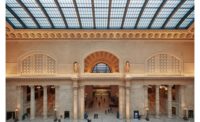Sustainable living is a popular topic in the building industry and many organizations and institutions are using smart technologies and environmentally responsible products on homes and buildings that are not only sustainable, but also functional.
The University of Georgia is leading such efforts by building a model home for sustainable living, so that students and visitors can learn about living smart and “improving efficiencies—human, natural, resources and energy.”
The Future Farmstead Program at University of Georgia is dedicated to the sustainable production of food and energy, and preservation of the environment.
Designed to take advantage of its rural setting in Tifton, Ga., the home will serve as an educational demonstration research facility and residence for the project’s graduate students.
The 3,000-square-foot, 2-story home, designed by Simone duBois and Denise Donahue of Camdus Construction with the assistance of UGA Family and Consumer Sciences, will be net-zero energy, economically and environmentally friendly with high expectations to be platinum LEED certified.
The home is expected to receive approximately 15,000 visitors per year, including K?12 groups, farmers, design and construction professionals, and people interested in learning about green building.
In addition to the house itself, the site includes a pond, land for an edible garden, an energy producing playground, and a greenhouse. The Future Farmstead project demonstrates how materials are applied in green building, and provides a way for guests to be hands?on with materials in application and increases awareness about sustainable living practices.
Contributing to this experience and the overall performance of the house are the Home Slicker rainscreen and HydroGap Drainable Housewrap from Benjamin Obdyke, one of America’s leading providers of high?quality roof and wall building solutions.
“The products we’ve specified are at the forefront of technology and when installed correctly, can extend the structure’s lifetime to hundreds of years,” said Tony Grahame, Green Building Technologies Professor at Moultrie Technical College, and Public Service Assistant Faculty at the University of Georgia. “I often see great materials installed incorrectly, and this home allows us to teach students, and visitors, how building materials should be installed to get their best performance.”
“So much is going into this house and most of it is pretty new technology,” said Dr. Craig Kvien, project leader and Crop and Soil Sciences Professor at UGA, “It’s important that everything works together really well, and to accomplish this we’ve been careful to select high quality products.”
The home was built tight, with plenty of insulation and solar panels. The team plans to keep the home updated as new materials and technologies become available over its long expected lifetime.
“Through our work on the project we have an opportunity to teach students about selecting appropriate building materials and technologies that can deliver expected performance,” explained Grahame. “That’s why we selected both the HomeSlicker and HydroGap products from Benjamin Obdyke.”
“Home Slicker proved to be ideal for the application as a rainscreen installed directly behind the James Hardie Color Plus cladding on the exterior of the house, over the zip system drainage system. These three products used together create an extremely durable exterior cladding system that effectively manages moisture from wind driven rain,” continued Grahame.
Benjamin Obdyke’s Home Slicker rainscreen effectively extends the lives of both commercial and residential buildings, using the technology to effectively act as a means for moisture management. By creating an air space between the back of the cladding and the face of the water resistance barrier, the rainscreen is able to reduce the forces that draw water into the wall assembly, and drain excess moisture via the air space.
The rainscreen system also helps dry moist air that escapes the interior wall assembly through diffusion by allowing air to move throughout the cavity between the cladding and the water resistant barrier. The performance benefits of HomeSlicker are essential to the longevity of Future Farmstead home and the success of the project.
HydroGap Drainable Housewrap was selected to be used on the carriage house exterior wall assembly to act as both an air barrier and drainage plain. Introduced in 2012, Benjamin Obdyke’s HydroGap Drainable Housewrap offers an effective exterior cladding moisture management system.
The high-performing product effectively controls excess moisture behind claddings, thereby preventing the damaging effects of mold and rot. Its patent-pending one millimeter spacers create a drainage plane between the sheathing and cladding allowing 100 times more bulk water to drain from a wall versus standard housewraps.
Additionally, HydoGap’s low-profile drainage space eliminates the need for design changes in the wall assembly and the product drains at least two times faster than other drainable housewraps. HydroGap requires no special tools for installation and is an effective means to manage moisture and air infiltration resulting in a better-built wall assembly.
The Future Farmstead home is in its final stages of completion and will soon become a model home for building smarter homes. The team hopes the home will show visitors how technology and appropriate building products can be built into a home to make it healthy, comfortable, energy and resource efficient, durable, and sustainable.
“It’s important to understand the big picture,” said Grahame. “It’s amazing how many houses are built that look great but don’t really perform well.”
Project Participants:
- University of Georgia
- Moultrie Technical College
- Camdus Construction
- U.S. Department of Agriculture
- U.S. Department of Labor










